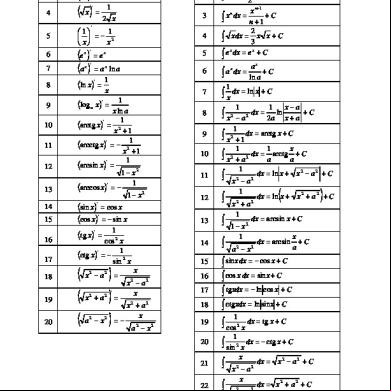Derivate 1w4vj
This document was ed by and they confirmed that they have the permission to share it. If you are author or own the copyright of this book, please report to us by using this report form. Report 3b7i
Overview 3e4r5l
& View Derivate as PDF for free.
More details w3441
- Words: 284
- Pages: 1
f ' ( a ) = lim x→ a
f ( x) − f ( a) x−a
(e ) = e x '
x
c' = 0
(2 ) = 2
x' = 1
( sin x ) ' = cos x
x '
(x ) = n⋅ x n '
n −1
x
⋅ ln 2
( cos x ) ' = − sin x 1 cos 2 x
(x ) = 2⋅ x
( tgx ) ' =
( x ) = 3⋅ x
( ctgx ) ' = −
2 '
3 '
( x) =
2
1
'
n
n ⋅ n x n −1
'
1 f' = − 2 f f
( x ) = 2 ⋅1 x
(f
( x) =
( f ⋅ g)' =
'
1
'
3
3
3 x
(x ) = α ⋅ x α '
2
α −1
1 sin 2 x
+ g) = f ' + g' '
f ' ⋅ g + f ⋅ g'
Consecinte:
'
1 1 =− 2 x x
( log a x ) ' =
1 x ⋅ ln a
( ln x ) ' = 1 x
( lg x ) ' =
1 x ⋅ ln 10
1 log 2 x = x ⋅ ln 2
(a ) = a x '
x
⋅ ln a
Daca avem o functie constanta sau o functie de derivat:
(c ⋅ f )' = c ⋅ f ' (− f )' = − f ' (f
− g) = f ' − g' '
'
f f ' ⋅ g − f ⋅ g' = g2 g
f ( x) − f ( a) x−a
(e ) = e x '
x
c' = 0
(2 ) = 2
x' = 1
( sin x ) ' = cos x
x '
(x ) = n⋅ x n '
n −1
x
⋅ ln 2
( cos x ) ' = − sin x 1 cos 2 x
(x ) = 2⋅ x
( tgx ) ' =
( x ) = 3⋅ x
( ctgx ) ' = −
2 '
3 '
( x) =
2
1
'
n
n ⋅ n x n −1
'
1 f' = − 2 f f
( x ) = 2 ⋅1 x
(f
( x) =
( f ⋅ g)' =
'
1
'
3
3
3 x
(x ) = α ⋅ x α '
2
α −1
1 sin 2 x
+ g) = f ' + g' '
f ' ⋅ g + f ⋅ g'
Consecinte:
'
1 1 =− 2 x x
( log a x ) ' =
1 x ⋅ ln a
( ln x ) ' = 1 x
( lg x ) ' =
1 x ⋅ ln 10
1 log 2 x = x ⋅ ln 2
(a ) = a x '
x
⋅ ln a
Daca avem o functie constanta sau o functie de derivat:
(c ⋅ f )' = c ⋅ f ' (− f )' = − f ' (f
− g) = f ' − g' '
'
f f ' ⋅ g − f ⋅ g' = g2 g





